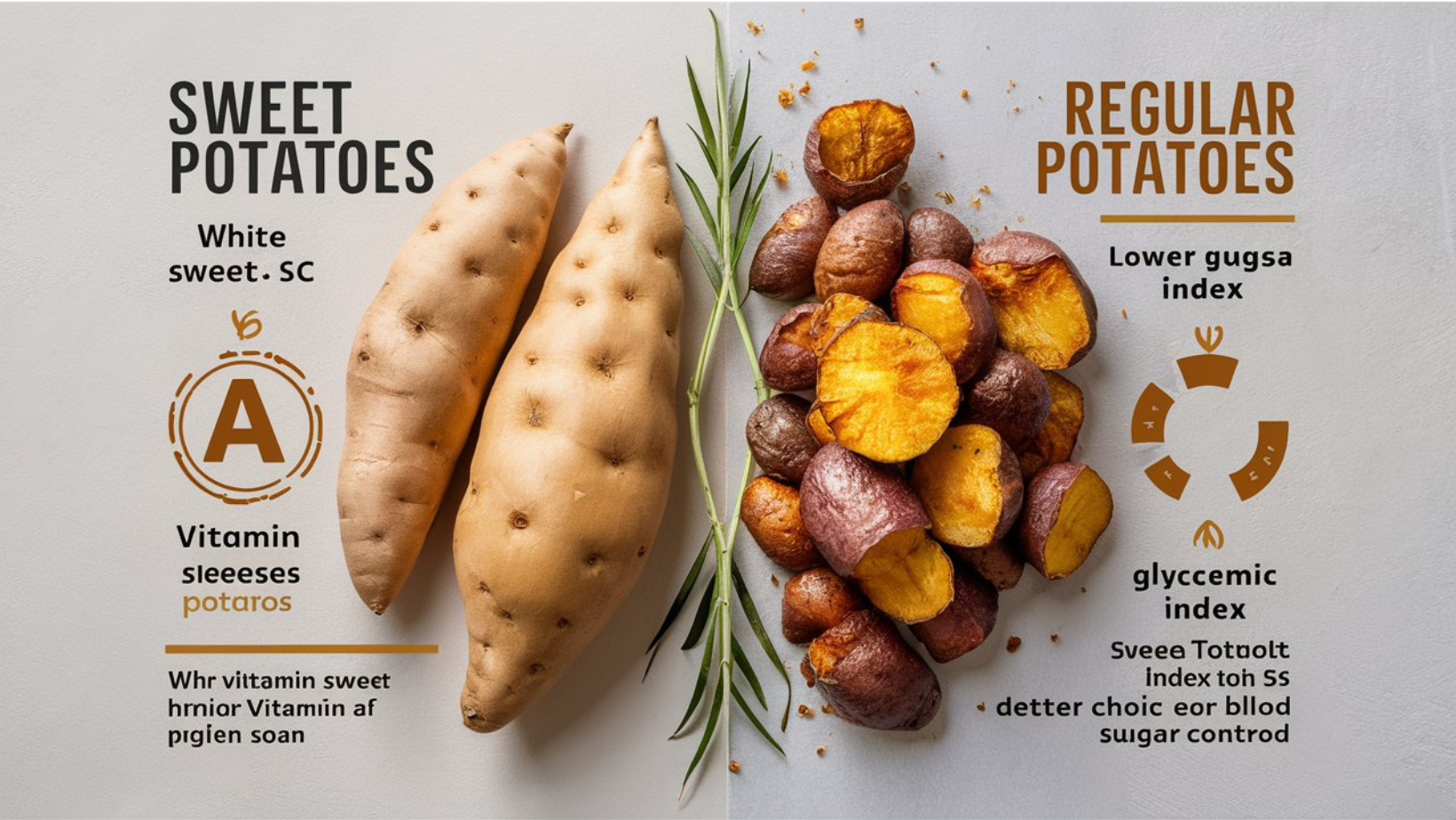Introduction to Potatoes and Health
Overview of White Sweet Potatoes and Regular Potatoes
In exploring the realm of healthy eating, the question often arises: Are white sweet potatoes healthier than regular potatoes? Both white sweet potatoes and regular potatoes are nutritional powerhouses and mainstays in global cuisines. This article dives deep into their nutritional profiles to unravel which type might be the better option for enhancing your diet. From their vitamin content to their impacts on health, we will compare these popular tubers side by side.
Importance of Understanding Nutritional Differences
Why delve into the nutritional nuances between these two? Well, understanding these differences can help individuals make informed dietary choices tailored to their health needs. Whether you’re managing a health condition, trying to lose weight, or simply aiming to optimize your nutrient intake, the choice between white sweet potatoes and regular potatoes can impact your dietary outcomes.
Detailed Nutritional Analysis
Macronutrient Comparison of White Sweet Potatoes and Regular Potatoes
When it comes to macronutrients—carbohydrates, proteins, and fats—both white sweet potatoes and regular potatoes bring something unique to the table. White sweet potatoes are slightly higher in calories and carbohydrates but provide a rich source of energy for the day. Regular potatoes, on the other hand, tend to have a bit more protein, making them a go-to for those looking to boost their protein intake without significantly increasing caloric load.
Carbohydrates, Proteins, and Fats Both types of potatoes contain complex carbohydrates, essential for sustained energy. However, the fiber content in white sweet potatoes is particularly noteworthy. It not only aids digestion but also helps maintain blood sugar levels, making it an excellent choice for those managing diabetes. Regular potatoes provide resistant starch, especially when cooled after cooking, which can benefit gut health.
Caloric Content Analysis Interestingly, while white sweet potatoes are higher in calories, they offer a lower glycemic index, which means they cause a slower rise in blood glucose levels. This can be particularly beneficial for long-term health, helping to manage weight and reduce spikes in blood sugar.
Micronutrients and Vitamins
Delving deeper into the nutritional content, we find that white sweet potatoes excel in providing certain micronutrients.
Vitamin C, A, and B Complex
White sweet potatoes are a powerhouse of vitamins A and C, both crucial for immune function, skin health, and vision. Regular potatoes, however, are not far behind with their vitamin C content. They also offer significant amounts of vitamin B6, which is vital for the nervous system and metabolic processes.
Essential Minerals – Iron, Magnesium, and Potassium
Regular potatoes take the lead in potassium, essential for heart health and proper muscle function. White sweet potatoes, however, provide ample iron and magnesium, making them an excellent choice for combating anemia and boosting energy levels.
Health Implications and Culinary Uses
Potential Health Benefits
Both white sweet potatoes and regular potatoes offer a spectrum of health benefits, but they each have their unique advantages. For instance, the high vitamin A content in white sweet potatoes supports vision health and immune function, while the antioxidants they contain can help combat oxidative stress in the body.
Antioxidant Properties White sweet potatoes are rich in beta-carotene, an antioxidant that the body converts into vitamin A. This nutrient is crucial for maintaining healthy skin, vision, and organ function. Moreover, the antioxidant properties of white sweet potatoes help reduce the risk of chronic diseases such as heart disease and cancer.
Dietary Recommendations Given their nutrient-rich profiles, both types of potatoes can be included in a healthy diet. However, it’s essential to consider preparation methods. Baking or boiling rather than frying can preserve the nutrients and reduce fat content, making these potatoes a healthier side dish or main course.
Culinary Uses and Recipes
The versatility of white sweet potatoes and regular potatoes extends to a myriad of culinary uses, from baked goods to savory dishes.
Versatility in Cooking White sweet potatoes can be used in both sweet and savory dishes. They are excellent baked, mashed, or sliced into fries. Regular potatoes are equally versatile, perfect for boiling, mashing, or roasting, and are a staple in dishes worldwide.
Recipe Ideas and Preparations Try incorporating white sweet potatoes into your meals by making a smooth, creamy soup or a healthy version of mashed potatoes with a dash of olive oil and herbs. Regular potatoes can be transformed into a comforting roast or a hearty stew, providing both flavor and nutrition.
As we delve further into this topic, we’ll address frequently asked questions in the next section, helping to clear up common misconceptions and provide practical advice on integrating these nutritious tubers into your diet. Stay tuned for valuable insights that might just change how you view and use these popular vegetables in your daily cooking.
FAQs (People Also Ask)
As we explore the depths of nutritional content and culinary versatility between white sweet potatoes and regular potatoes, several questions often arise. Here are some of the most common queries:
Are white sweet potatoes better for weight loss than regular potatoes?
White sweet potatoes have a lower glycemic index compared to regular potatoes, which means they cause a slower increase in blood sugar levels. This attribute can help in weight management, as it may contribute to a feeling of fullness and reduced hunger. However, both types can be part of a weight loss diet if prepared healthily and consumed in moderation.
What are the glycemic index differences?
The glycemic index (GI) of white sweet potatoes is generally lower than that of regular potatoes. This makes white sweet potatoes a better option for those managing diabetes, as they help maintain steadier blood glucose levels. Regular potatoes, however, can still be enjoyed, particularly if they are eaten with their skins on, which increases their fiber content and lowers their GI.
Can white sweet potatoes be a staple in a diabetic diet?
Yes, due to their lower glycemic index and high fiber content, white sweet potatoes can be a healthier staple in a diabetic diet. They provide sustained energy without the rapid spikes in blood sugar associated with higher GI foods. However, portion control and preparation methods are crucial to maximizing their benefits.
These FAQs address common concerns and highlight the nutritional advantages of both white sweet potatoes and regular potatoes. Each has its place in a balanced diet, contributing valuable nutrients and health benefits. Whether you choose white sweet potatoes or regular potatoes, both can be enjoyed in a variety of dishes that support overall health and wellness.

